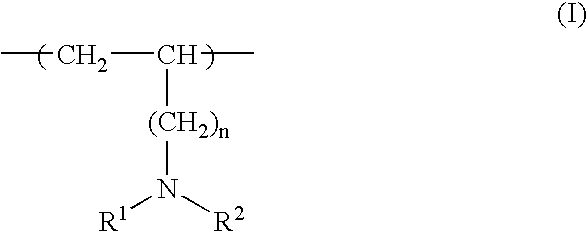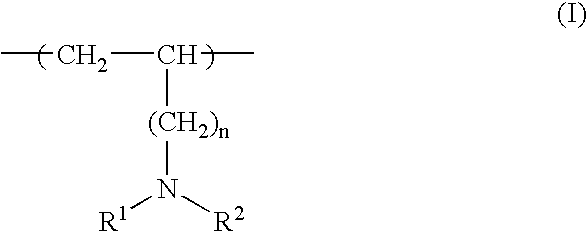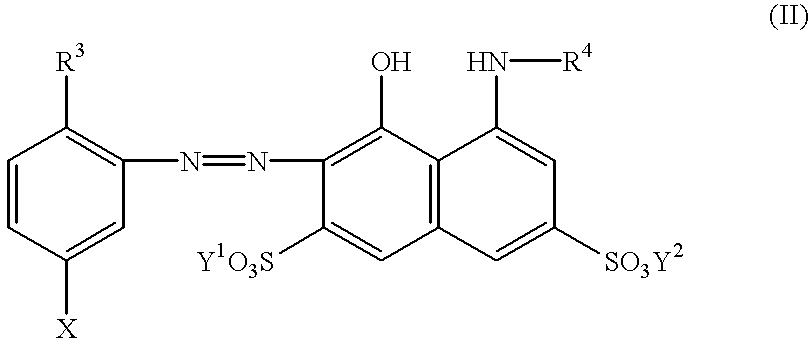Ink composition comprising cationic, water-soluble resin
a technology of cationic and water-soluble resins, applied in the field ofink compositions, can solve the problems of photodecomposition of prints and the inability to develop waterproofness in images
- Summary
- Abstract
- Description
- Claims
- Application Information
AI Technical Summary
Benefits of technology
Problems solved by technology
Method used
Image
Examples
example 1
Preparation of Polyallylamine (PAA) Hydrochloride
To 57.1 g of monoallylamine (1 mol) was added 101.4 g (1 mol) of 36% hydrochloric acid. Thus, a 59% aqueous monoallylamine hydrochloride solution was prepared. The solution was concentrated by means of a rotary evaporator to a concentration of 67%. 2,2'-azobis-(2-amidinopropane) dihydrochloride (0.01 mol) was added to the concentrate, and polymerization was carried out at 50.degree. C. for 24 hr. After the completion of the polymerization, the resultant polymer was purified and dried to give PAA hydrochloride. The yield was 90%.
example 2
Dehydrochlorination of PAA Hydrochloride
PAA hydrochloride (10 g) prepared in Example 1 was dissolved in 90 g of ultrapure water, and the acid portion of the PAA hydrochloride was then removed by using an ion exchange resin (IRA 900, manufactured by Organo Corp.) which had been previously ion-exchanged with sodium hydroxide. The resin thus obtained had an average molecular weight of 5,000.
example 3
Preparation of Low-molecular Weight PAA
Monoallylamine (286 g, 5 mol) was added dropwise to 550 g (5.3 mol) of 35% hydrochloric acid with stirring at 5 to 10.degree. C. under ice cooling. After the addition of monoallylamine was completed, water and hydrogen chloride were removed at 60.degree. C. under reduced pressure by means of a rotary evaporator to give a white crystal. The crystal was dried at 80.degree. C. under reduced pressure to give 485 g of monoallylamine hydrochloride. The water content of the hydrochloride was measured by thermal analysis (TG) and found to be 4.8%.
The monoallylamine hydrochloride thus prepared was dissolved in water to prepare a 70% aqueous solution of the monoallylamine hydrochloride. A radical initiator, 2,2'-azobis-(2-amidinopropane)dihydrochloride (0.01 mol), was added to 50 g of the aqueous solution, and 25 g of 35% hydrochloric acid was further added thereto. Thereafter, the mixture was allowed to stand at 60.degree. C. for 40 hr, thereby permitti...
PUM
| Property | Measurement | Unit |
|---|---|---|
| water content | aaaaa | aaaaa |
| time | aaaaa | aaaaa |
| temperature | aaaaa | aaaaa |
Abstract
Description
Claims
Application Information
 Login to View More
Login to View More - R&D
- Intellectual Property
- Life Sciences
- Materials
- Tech Scout
- Unparalleled Data Quality
- Higher Quality Content
- 60% Fewer Hallucinations
Browse by: Latest US Patents, China's latest patents, Technical Efficacy Thesaurus, Application Domain, Technology Topic, Popular Technical Reports.
© 2025 PatSnap. All rights reserved.Legal|Privacy policy|Modern Slavery Act Transparency Statement|Sitemap|About US| Contact US: help@patsnap.com



